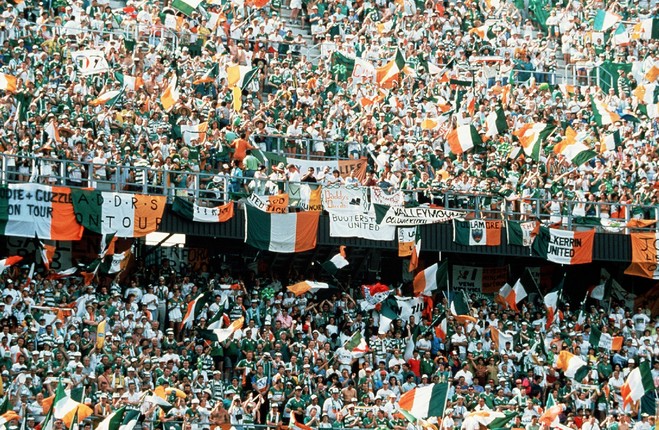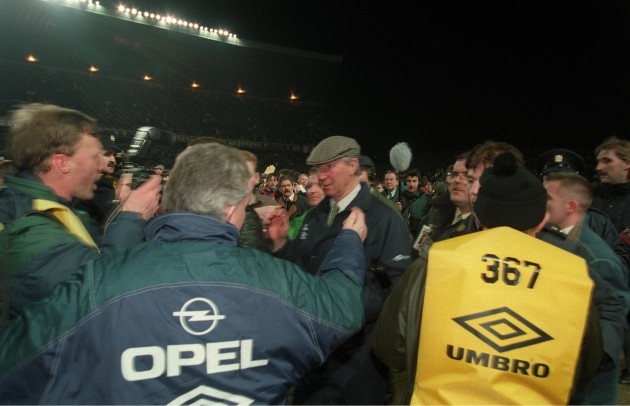WHAT WITH NOSTALGIA being a reliable Irish currency and Jack’s Army its gold standard, this 30-year milestone will bring with it a slew of Italia ’90 retrospects.
First up: The Boys in Green, a documentary split across the next two Monday nights on RTÉ One. It’s directed by Ross Whitaker (Katie, Shane Lowry: Open, Between Land and Sea) and is produced by Loosehorse, whose past work includes Giles, Micko, and The Man Who Wanted to Fly.
As you’d expect, the documentary has all of the joys and the yarns and the pints and the songs of The Charlton Years; the Danger Heres and the It’s Theres; the first-rate talent and the second-hand smoke; the finger-jabbing and the pen-throwing; the celebrated draws and the derided Dunph; the flat caps and the high press; the goals, the forward rolls, and the sheer, heady ecstasy of innocent days.
But this isn’t just Reeling in the Years.
The film was initially conceived as a retrospective on the Lansdowne Riots of 1995, but expanded from there to encompass the whole Charlton era, and looks at Jack’s Army as the bandwagon we rode all the way to modernity.
(Or at least to what a lot of other European countries called the post-war era.)
“Ireland was beginning to change”, says Ross Whitaker. “It was when the church was losing its stranglehold on the country, there were tons of scandals around the Church, we came out of a recession that seemed to last forever. Emigration was starting to reduce, there were so many things changing in that time. What was the significance of the Irish football team and its success within that historical period?”
The documentary answers that by posing another question. What was the significance of the English football team and its lack of success within that historical period?
Watching it, you’re reminded of just how often we played them: Euro ’88, Italia ’90, Euro ’92 qualifying, and the friendly game that ended with riots in 1995. (They were truly the Denmark of their day.)
The film addresses how an English manager was treated in Ireland, but it also looks at how the the English manager of Ireland was treated in England. It gives particular focus to Charlton’s return to Wembley for Euro ’92 qualifying, and he seems to have been deeply hurt by chants of “Judas” from a crowd for whom he won a World Cup.
The footage of Charlton scuffling with fans on the pitch during the riots in 1995 remains bracing, and the significance of that moment is dwelled on, too.
“As Dave Kelly says, he thinks that night affected him more than people realise, and I think that stands to reason”, reflects Whitaker.
But hey, let’s not ignore the good times. As Lise Hand points out in the film, this era afforded Irish people a chance to fly the tricolour – a flag much of the world saw as indelibly linked to the IRA – as a non-political slogan for the first time.
“Through the interviewees, what I found interesting was that idea of Irish pride”, says Whitaker. “It’s a bit of a cliché, but if you grew up in the 1980s, you knew that Ireland was a very depressing and very depressed place.
“There wasn’t a lot of positivity around, there wasn’t a lot of pride in having an Irish accent or waving an Irish flag, and partially – if not entirely – that changed because of the Irish football team.
“That’s partly down to the team, but how the fans represented themselves was of more significance. There was a land grab of the idea of being a really positive force, and part of that was in contradiction to what the English fans were doing at the time.”
The phenomenon of the travelling Irish support, as much the image of this era as the football team, was largely created in opposition to the culture of English hooliganism that the competition organisers tried to confine to the island of Sicily.
“I certainly believe that to be the case”, says Whitaker. “One of the things I remember very clearly from the time were English newspapers writing big op-eds about the Irish fans and their behaviour, wondering why the English fans couldn’t behave like that. And of course we loved that.
“We loved the idea we were being held in such a positive light, and additionally the English fans were so hated and reviled around the world at that point.”
That the tricolour wasn’t apolitical to everyone is explored too, as the film tells the tale of how that caustic night in Lansdowne Road in 1995 was infiltrated by the English far-right fringe group Combat 18.
There is a terrific range of talking heads across the two parts, with Gary Lineker a genial, generous contributor and John Aldridge the star turn. But let’s give the final word here to Eamon Dunphy, who has mellowed from those hardscrabble days.
“The Charlton Years were a lovely time. They were fun, they brought people together…and we beat England.”
The Boys in Green airs Monday, 9 March and Monday, 16 March on RTÉ One at 9.30pm.


